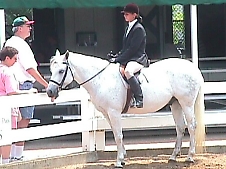 After the show, many of the horses were
brought to ringside for the audience to photograph and pet. From
there we wandered back down the hill to the main show barn where
there was a miniature horse competition in progress. It was
actually cool under the large roof with open sides. We watched
the "Youth Pleasure Driving Stake" as Ashley Harris
rode Hidden Valley Rainbow, owned by Mary Howard, to a first
place finish. We then proceeded to the Hall of Champions which
was built in the early 1900's and served as the stallion barn
when the property was the Walnut Hall Farms. Today its four lush
paddocks are reserved for
After the show, many of the horses were
brought to ringside for the audience to photograph and pet. From
there we wandered back down the hill to the main show barn where
there was a miniature horse competition in progress. It was
actually cool under the large roof with open sides. We watched
the "Youth Pleasure Driving Stake" as Ashley Harris
rode Hidden Valley Rainbow, owned by Mary Howard, to a first
place finish. We then proceeded to the Hall of Champions which
was built in the early 1900's and served as the stallion barn
when the property was the Walnut Hall Farms. Today its four lush
paddocks are reserved for 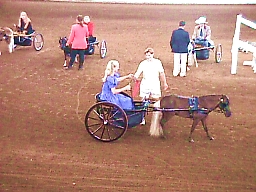 only
those equine residents of the Horse Park who have distinguished
themselves as true champions. Such money winners as
"Stanley", "Staying Together" and "Sky
Watch", all million dollar earners, were brought out and
walked around in the small ring as their impressive statistics
were chanted off. The ring is small and the horses big. Up close
and personal is an understatement. We finished
only
those equine residents of the Horse Park who have distinguished
themselves as true champions. Such money winners as
"Stanley", "Staying Together" and "Sky
Watch", all million dollar earners, were brought out and
walked around in the small ring as their impressive statistics
were chanted off. The ring is small and the horses big. Up close
and personal is an understatement. We finished 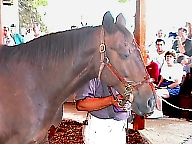 the day by
crossing back toward the visitor's center to take in the
International Museum of the Horse. This took us past the Draft
Horse Barn. These are the most massive type of horses used for
pulling heavy loads. They weigh at least 1500 lbs. and usually
about 2000. Shires are generally considered the tallest breed.
Many are as tall as 19.2 hands. The Belgian is generally
considered the heaviest breed. The most famous of which is the
Budweiser beer-wagon-pulling Clydesdales. The International
Museum of the Horse was our final stop. Inside, the history of
the horse is traced from the skeletons of the pre-historic
ancestors, to modern-day
the day by
crossing back toward the visitor's center to take in the
International Museum of the Horse. This took us past the Draft
Horse Barn. These are the most massive type of horses used for
pulling heavy loads. They weigh at least 1500 lbs. and usually
about 2000. Shires are generally considered the tallest breed.
Many are as tall as 19.2 hands. The Belgian is generally
considered the heaviest breed. The most famous of which is the
Budweiser beer-wagon-pulling Clydesdales. The International
Museum of the Horse was our final stop. Inside, the history of
the horse is traced from the skeletons of the pre-historic
ancestors, to modern-day 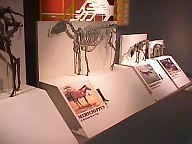 usage in the sports fields. The walls are chocked full of tidbits
of trivia such as; Horses really can sleep standing up. They
sleep lightly while standing but for complete rest they will lie
down for short periods each day. Altogether horses don't sleep
much, 2 to 3 hours per day. The world of horses are broken
into two major groups: warm-blooded and cold-blooded. There is no
biological difference between a warm-blooded and cold-blooded
horse. Horses descended from the smaller Arabian or Barb are
considered warm-blooded. All other horses are cold-blooded,
including modern-day draft horses. And one I didn't know: Why we
drive on the right side of the road. Well it seems that it can be
credited to the Conestoga wagon. The
usage in the sports fields. The walls are chocked full of tidbits
of trivia such as; Horses really can sleep standing up. They
sleep lightly while standing but for complete rest they will lie
down for short periods each day. Altogether horses don't sleep
much, 2 to 3 hours per day. The world of horses are broken
into two major groups: warm-blooded and cold-blooded. There is no
biological difference between a warm-blooded and cold-blooded
horse. Horses descended from the smaller Arabian or Barb are
considered warm-blooded. All other horses are cold-blooded,
including modern-day draft horses. And one I didn't know: Why we
drive on the right side of the road. Well it seems that it can be
credited to the Conestoga wagon. The 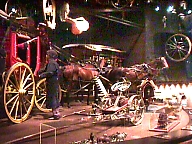 Conestoga
was driven by a "waggoner" who rode the near (left)
wheel horse. He managed his team of six horses with verbal
commands, a single jerk line, and a long blacksnake whip which
cracked the air yet hardly ever touched a horse. Because of his
position on the left of his team, the driver held to the right
side of the road. Smaller on-coming vehicles were forced to their
right to pass. Soon it was custom for all drivers to keep to the
right of the road. However early motor vehicles placed the driver
on the right until Henry Ford established the driver on the left
side in 1909.
Conestoga
was driven by a "waggoner" who rode the near (left)
wheel horse. He managed his team of six horses with verbal
commands, a single jerk line, and a long blacksnake whip which
cracked the air yet hardly ever touched a horse. Because of his
position on the left of his team, the driver held to the right
side of the road. Smaller on-coming vehicles were forced to their
right to pass. Soon it was custom for all drivers to keep to the
right of the road. However early motor vehicles placed the driver
on the right until Henry Ford established the driver on the left
side in 1909. 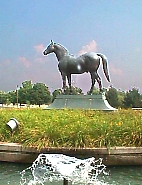 On
our way out, I couldn't resist walking out to the largest
memorial in the park. The statue of Man o' War. The greatest race
horse and leading money winner of his day. Winner of twenty of
the twenty-one starts with lifetime earnings of $49,465. Foaled
on March 29, 1917 at August Belmont's Nursery Stud a few miles
away, he was sold at auction as a yearling for $5000.00 to Samuel
D. Riddle, his owner throughout his racing career and later
retirement. He had an unparalleled 28 foot stride. "Big
Red" sired 62 stakes winners. His "get earnings"
were over $3.5 million. War Admiral, a Triple Crown winner, was
the most famous of his offspring. Man o' War died November, 1. 1947 and
lies buried beneath his statue on the grounds.
On
our way out, I couldn't resist walking out to the largest
memorial in the park. The statue of Man o' War. The greatest race
horse and leading money winner of his day. Winner of twenty of
the twenty-one starts with lifetime earnings of $49,465. Foaled
on March 29, 1917 at August Belmont's Nursery Stud a few miles
away, he was sold at auction as a yearling for $5000.00 to Samuel
D. Riddle, his owner throughout his racing career and later
retirement. He had an unparalleled 28 foot stride. "Big
Red" sired 62 stakes winners. His "get earnings"
were over $3.5 million. War Admiral, a Triple Crown winner, was
the most famous of his offspring. Man o' War died November, 1. 1947 and
lies buried beneath his statue on the grounds. 
 <<<<< Back
HOME PAGE
<<<<< Back
HOME PAGE
